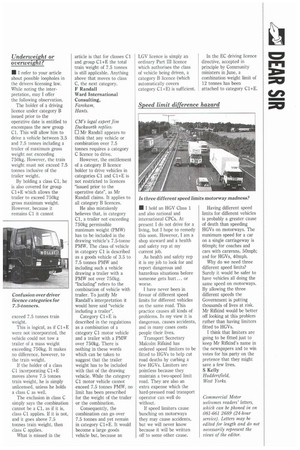Underweight or overweight?
Page 41

If you've noticed an error in this article please click here to report it so we can fix it.
IIII I refer to your article about possible loopholes in the drivers licensing law. While noting the interpretation, may I offer the following observation.
The holder of a driving licence under category B issued prior to the operative date is entitled to encompass the new group Cl. This will allow him to drive a vehicle between 3.5 and 7.5 tonnes including a trailer of maximum gross weight not exceeding 750kg. However, the train weight must not exceed 7.5 tonnes inclusive of the trailer weight.
By holding a class Cl, he is also covered for group C1+E which allows the trailer to exceed 750kg gross maximum weight. However, because it remains Cl it cannot exceed 7.5 tonnes train weight.
This is logical, as if C1+E were not incorporated, the vehicle could not tow a trailer of a mass weight exceeding 750kg. It makes no difference, however, to the train weight.
If the holder of a class Cl incorporating Cl+E moves above 7.5 tonnes train weight, he is simply unlicensed, unless he holds a class C as well.
The exclusion in class C simply says the combination cannot be a Cl, as if it is, class Cl applies. If it is not, and it goes above 7.5 tonnes train weight, then class C applies.
What is missed in the article is that for classes Cl and group Cl+E the total train weight of 7.5 tonnes is still applicable. Anything above that moves to class C, the next category.
F Randall Ward International Consulting, Fareham, Hants.
CM'S legal expert jim Duckworth replies: 0 Mr Randall appears to think that any vehicle or combination over 7.5 tonnes requires a category C licence to drive.
However, the entitlement of a category B licence holder to drive vehicles in categories Cl and Cl+E is not restricted to licences "issued prior to the operative date", as Mr Randall claims. It applies to all category B licences.
He also mistakenly believes that, in category a trailer not exceeding 750kg permissible maximum weight (PMW) has to be included in the drawing vehicle's 7.5-tonne PMW. The class of vehicle in category Cl is described as a goods vehicle of 3.5 to 7.5 tonnes PMW and including such a vehicle drawing a trailer with a PMW not over 750kg. "Including" refers to the combination of vehicle with trailer. To justify Mr Randall's interpretation it would have said "vehicle including a trailer".
Category C1+E is described in the regulations as a combination of a category Cl motor vehicle and a trailer with a PMW over 750kg. There is nothing in these words which can be taken to suggest that the trailer weight has to be included with that of the drawing vehicle. While the category Cl motor vehicle cannot exceed 7.5 tonnes PMW, no limit has been prescribed for the weight of the trailer or the combination.
Consequently, the combination can go over 7.5 tonnes and yet remain in category Cl+E. It would become a large goods vehicle but, because an LGV licence is simply an ordinary Part III licence which authorises the class of vehicle being driven, a category B licence (which automatically covers category Cl+E) is sufficient. In the EC driving licence directive, accepted in principle by Community ministers in June, a combination weight limit of 12 tonnes has been attached to category Cl+E.




















































































































